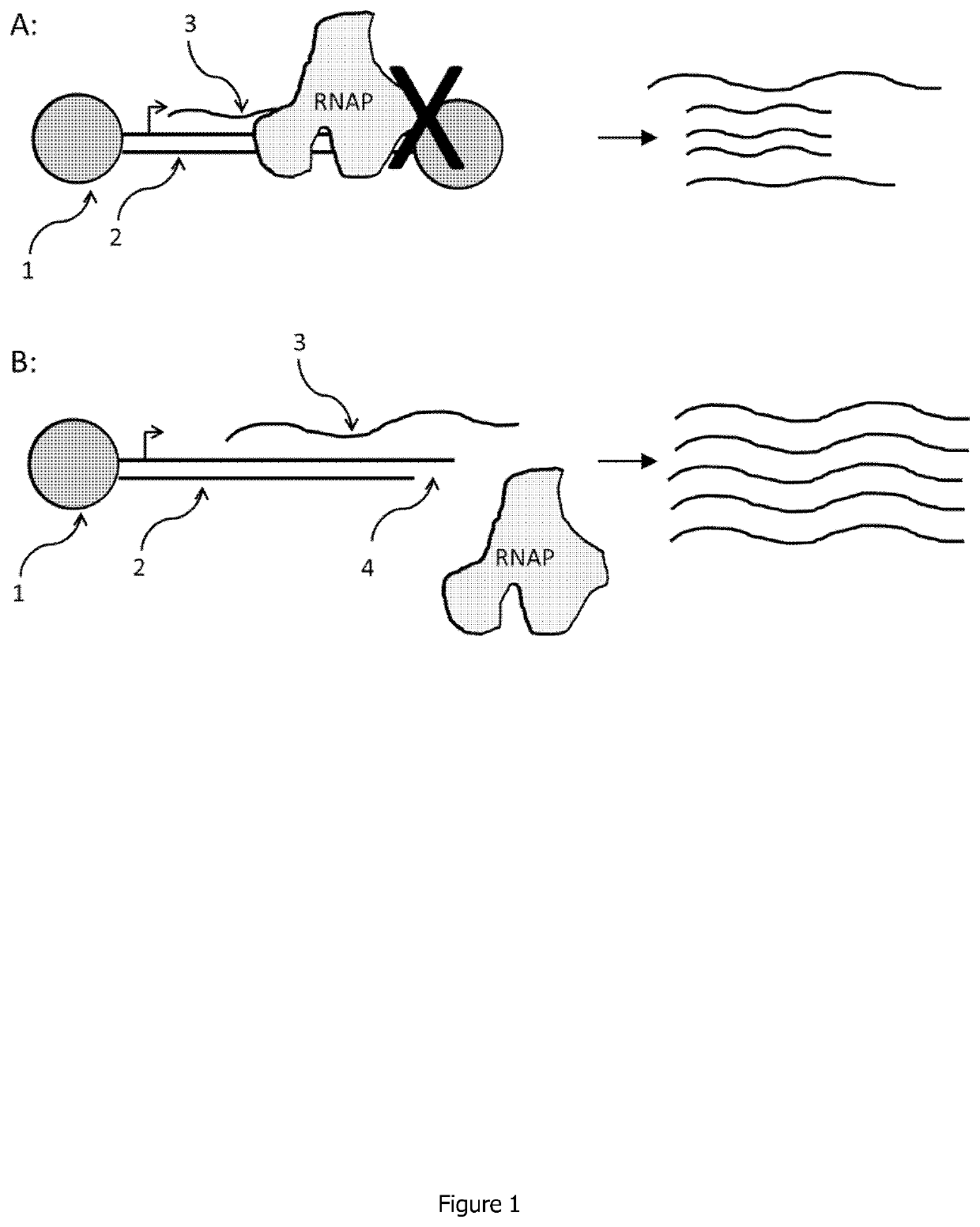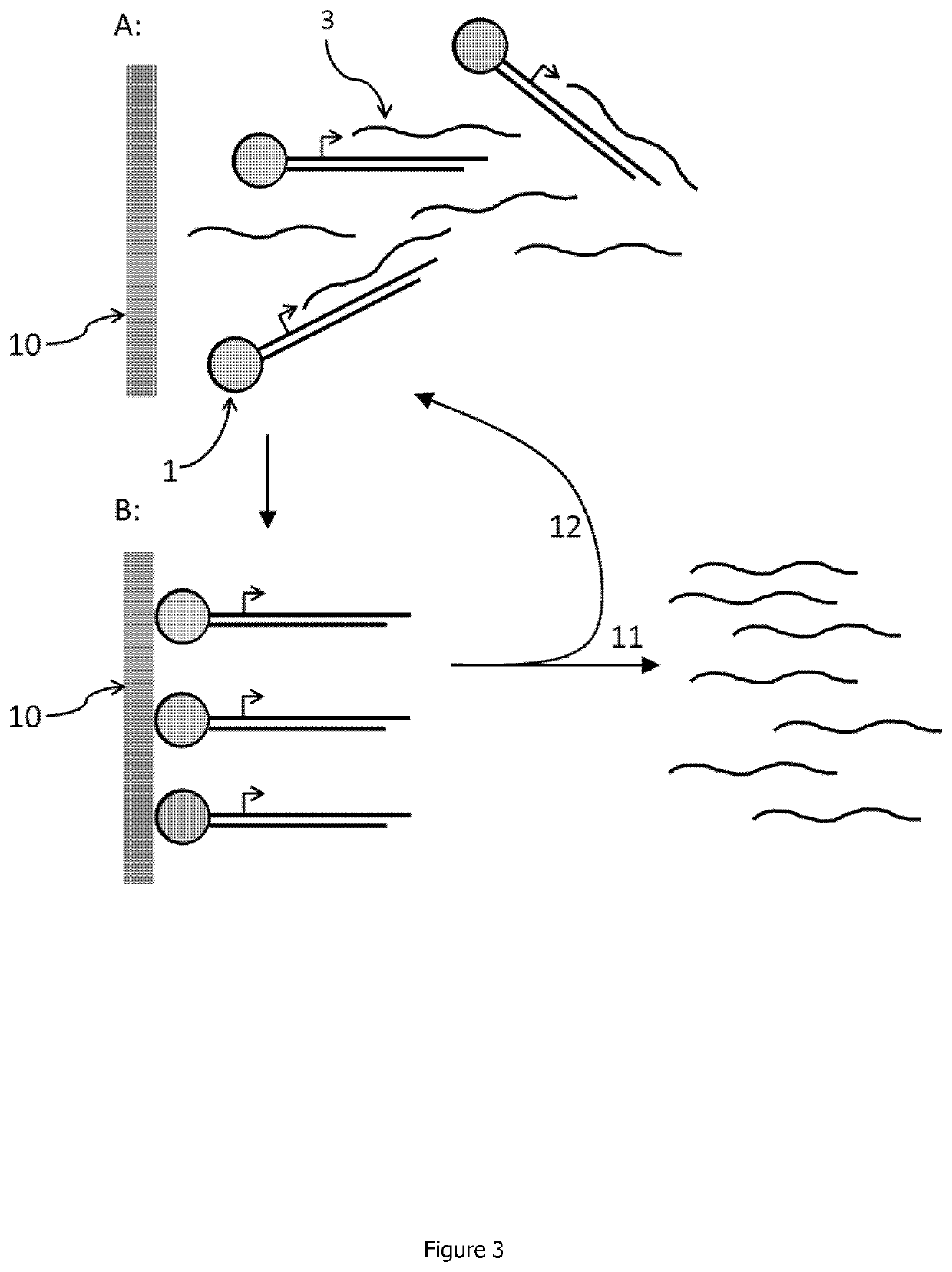Linear double stranded DNA coupled to a single support or a tag and methods for producing said linear double stranded DNA
a technology of dna and single support, applied in the field of linear double stranded dna, can solve the problems of large cost factor of industrial scale, inconvenient production of dna template, error-prone pcr-based dna template, etc., and achieve the effect of accelerating the cuaac reaction
- Summary
- Abstract
- Description
- Claims
- Application Information
AI Technical Summary
Benefits of technology
Problems solved by technology
Method used
Image
Examples
example 1
of Linearized DNA to CnBr-Activated Sepharose
[0353]The aim of this example was to find out whether linearized DNA can be coupled to CnBR-activated sepharose and if so, whether said DNA is still accessible to enzymatic reactions.
[0354]1 μg of plasmid DNA (SEQ ID NO: 1) was linearized using either 10 U XbaI to generate sticky DNA ends or 10 U PvuII to generate blunt DNA ends. The restriction reaction was performed in 20 μl 1× restriction buffer at 37° C. for 1 hour. Subsequently, the reaction was analyzed on a 0.8% agarose gel by agarose gel electrophoresis to ensure complete linearization. Linear DNA was purified using AMPure XP beads (Beckman coulter) according to the manufacturer's instructions.
[0355]The coupling of XbaI- or PvuII-linearized DNA on CnBr-activated 4B or 6 MB sepharose (GE Healthcare) was performed according to the manufacturer's instructions. In brief, 4B or 6 MB sepharose was suspended, allowed to swell in 1 mM HCl and subsequently washed. For coupling, sepharose w...
example 2
of Linearized DNA to NH2 Beads Using EDC / Sulfo-NHS
[0361]The aim of this example was to find out whether linearized DNA which is coupled to NH2 beads using EDC sulfo-NHS is still accessible to enzymatic reactions.
[0362]1 mg plasmid DNA (SEQ ID NO: 1) was linearized using 500 U PvuII to generate blunt DNA ends. The restriction reaction was performed in 5 ml 1× restriction buffer at 37° C. for 2 hours. The resulting blunt DNA ends were dephosphorylated for 30 minutes at 37° C. using 300 U alkaline phosphatase to prevent re-ligation. The phosphatase reaction was stopped by adding 0.1% SDS for 10 minutes at 65° C. Afterwards, the linearized and dephosphorylated DNA was washed with 1 ml ice cold propanol and centrifugated at 20,000 g for 20 minutes at room temperature. The pellet was dried for 10 to 30 minutes. Then the DNA was further digested with AseI for 2 hours at 37° C. to generate carboxylate groups, which are mandatory for coupling to NH2-beads via EDC / sulfo-NHS and subsequently w...
example 3
of Linearized DNA to Azide-Biotin Via Cu(I)-Catalyzed Azide-Alkyne Cycloaddition (CuAAC) and Subsequent Association with Magnetic Streptavidin Beads
[0367]The aim of this example was to find out whether linearized plasmid DNA can be coupled to azide-biotin via CuAAC (so called “click” reaction) and can be further associated to streptavidin beads and if so, whether said DNA is still accessible to enzymatic reactions.
[0368]1 mg of plasmid DNA (SEQ ID NO: 1) was linearized using 200 U PvuII for 2 hour at 37° C. and 600 rpm to generate blunt DNA ends. The linearized DNA was purified using AMPure XP beads and the restriction reaction was analyzed via agarose gel electrophoresis as described in Example 1.
[0369]Alkyne moieties which react to azide-biotin and enable association of the linearized DNA with streptavidin were generated by adenylating 300 μg of linearized DNA with 40 μM 7-ethynyl-dATP and 1 U Taq-polymerase for 55 minutes at 72° C. and 1000 rpm. Adenylation using dATP was perform...
PUM
| Property | Measurement | Unit |
|---|---|---|
| Atomic weight | aaaaa | aaaaa |
| Atomic weight | aaaaa | aaaaa |
| Atomic weight | aaaaa | aaaaa |
Abstract
Description
Claims
Application Information
 Login to View More
Login to View More - R&D
- Intellectual Property
- Life Sciences
- Materials
- Tech Scout
- Unparalleled Data Quality
- Higher Quality Content
- 60% Fewer Hallucinations
Browse by: Latest US Patents, China's latest patents, Technical Efficacy Thesaurus, Application Domain, Technology Topic, Popular Technical Reports.
© 2025 PatSnap. All rights reserved.Legal|Privacy policy|Modern Slavery Act Transparency Statement|Sitemap|About US| Contact US: help@patsnap.com



